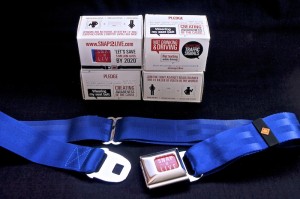07 – Snap-2-Live & Seat Belts: Where Safety and Fashion “Click” Together

December 1, 2013 | Posted in Global Road Safety, Podcast Episodes | By Traffic Safety Guy
Comments Off on 07 – Snap-2-Live & Seat Belts: Where Safety and Fashion “Click” Together
Podcast: Play in new window | Download
Subscribe: RSS
A Conversation with Ernesto Arguello
Ernesto Arguello is an international entrepreneur focused on creating new ventures that offer opportunities for others, which includes traveling everywhere to save lives with a “simple” message: Snap-2-Live.
Recognizing that traffic crashes are the number one killer of youth around the globe, Ernesto looked for a way to make a difference and stop the carnage. One of the most effective and simplest ways he found is for everyone to buckle their seat belt when in a car. However, being a proponent of encouraging youth to remember to fasten their seat belts can be challenging. His solution? Snap-2-Live.
Safety Belts and Snap-2-Live
Snap-2-Live is a belt worn for everyday activities that looks like a seat belt from a car. Made of the same type of material but with bright colors, it stands out, and family and friends see it and ask what it represents. By wearing the belt, it is Ernesto’s expectation that it will spark a discussion on the importance of wearing a seat belt, and create an easy reminder to use it in the car.
Ernesto has a deep belief in the importance of education. The son of refugees, he learned that education is something we can take with us anywhere we go—no matter what other possessions we do or do not have. That belief has driven his effort to educate everyone about seat belts. The outside of the packaging for a Snap-2-Live belt asks for a pledge to “join the fight against road crashes” by:
- Wearing a seat belt
- Not drinking and driving
- Not texting while driving, and
- Respecting traffic signals
While raising awareness of road safety issues, Ernesto is also elevating communities in Latin America. Using education as a base, he is creating and building “sustainable communities that offer housing, infrastructure, education, health, recreation and entrepreneurial programs,” called Education Model Towns.
The Decade of Action for Road Safety

David and Ernesto at the Launch Network Event
Also in this episode, David Wallace, the Traffic Safety Guy, discusses global traffic safety issues and why the U.N. has declared 2011-2020 to be the Decade of Action for Road Safety. From the research we know:
- Road traffic crashes take the lives of nearly 1.3 million people every year, with almost half being pedestrians, cyclists and motorcyclists.
- Between 20-50 million people are injured in crashes.
- Road traffic injuries have become the leading cause of death for people 15–29 years of age
Failing to wear seat belts is one of the five critical risk factors identified by the United Nations in its effort to increase road safety. The other four are: speed, drink-driving, failing to wear helmets, and not using child restraints. In other words, when worn, seat belts can lessen the impact of the other risk factors. For example, someone impaired from drink-driving but wearing a seat belt is more likely to survive a crash than someone who isn’t wearing one.
Wearing a seat belt is a critical road safety component. Snap-2-Live challenges everyone to make a fashion statement: always “click” the two ends together when in a car and save lives.
How have seat belts made a difference in your life?
RELATED LINKS:
Websites:
- Decade of Action for Road Safety
- Education Model Towns
- FIA Foundation
- Inter-American Development Bank
- Launch Network
- Snap-2-Live
- The Extra Mile
- The Extra Mile Episode with Ernesto Arguello
Research:
- Attitudes Towards Seat Belt Use
- Global Status Report on Road Safety 2013
- Seat-belts: The Facts Infograph
Other:
Video Clips:
06 – Parents – A Critical Component for Safer Teen Driving

November 23, 2013 | Posted in Podcast Episodes, Teen Driving | By Traffic Safety Guy
Comments Off on 06 – Parents – A Critical Component for Safer Teen Driving
Podcast: Play in new window | Download
Subscribe: RSS
A Conversation with Tim Hollister
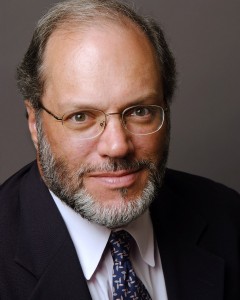
Tim Hollister is a national expert on teen driving and author of the book Not So Fast: Parenting Your Teen Through the Dangers of Driving. As a parent whose 17 year-old son, Reid, died in a one-car crash while driving, Tim brings a unique perspective to the information parents must have in order to determine if their daughter or son should be driving. In Not So Fast, Tim presents a clear description of the risks teens face every time they get behind the wheel. He provides parents the benefit of his years of research and discusses specific recommendations aimed at decreasing the inherent dangers associated with teen driving.
In our conversation, Tim recounts his belief that prior to his son’s death he considered himself to be a well-informed parent about the risks his son faced while driving, and the steps he took afterwards to correct that mistaken belief. Tim’s book is designed to “help parents understand the real risks of teen driving” and assist them in determining if their teen should be driving on a particular day, or at all.
Teens and Safe Driving

Reid Hollister
In this episode Tim discusses a critical wrong assumption many parents make: that their teen is a good person and therefore a safe driver. In other words, the erroneous belief that it is the other driver who is the problem. As Tim points out, it is not possible for teens to have the necessary skills to be risk-free drivers due to a combination of biology, inexperience, and the essential time needed to hone one’s skills. Our brains and judgment are not fully developed until our mid-twenties. Add to this the fact that it takes three to five years of driving experience to become relatively safe drivers, and science and research tell us that no teen can be a completely safe driver.
This does not mean that parents cannot help their teens to be SAFER drivers. They can. It means that parents need to understand a teen’s limitations by being informed and then acting on that knowledge. During our discussion Tim provides critical considerations for parents and teen drivers, such as knowing the difference between purposeful driving and joyriding, and the importance of a Teen Driving Agreement (TDA). A model TDA is provided in his book.
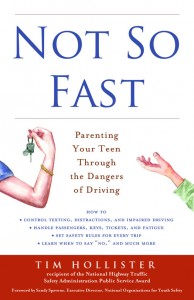
Not So Fast
Created from his blog, From Reid’s Dad, Tim Hollister shares the best of his blog posts in twenty-six short chapters packed with priceless information,including:
- Why there is no Such Thing as a Safe Teen Driver
- What Driver’s Ed Isn’t
- The ABC of GDL (Graduated Driver Licensing)
- Negotiating and Enforcing a Teen Driving Agreement
- Managing Curfews, and
- Supervising the Brand-New Driver.
Tim helps parents understand the issues and how essential parental supervision is to the safety of their teens and everyone else on the road. Not So Fast is a must-read for any parent with a teen driver and this podcast episode is a great discussion of the author’s deeply personal experience and wealth of knowledge on the perils of teen driving.
RELATED LINKS:
Websites:
Resources:
Other:
- Traffic Safety Guy Blog – Teen Driving – I Know Everything
- Traffic Safety Guy Blog – Teen Driving – Speeding and Teenagers: Watch Out Parents–It’s a Deadly Combination
- Traffic Safety Guy Blog – Teen Driving: Parents, There Is More To Do
Video:
- Tim Hollister interviewed by Monika Samtani on the Extra Mile
- Teen Driver Safety: Reid’s Story
http://youtu.be/5KLii3Mhkps
05 – Child Safety Seats: Buckle Up—Every Ride, Every Time

November 1, 2013 | Posted in Child Safety Seats, Podcast Episodes | By Traffic Safety Guy
Comments Off on 05 – Child Safety Seats: Buckle Up—Every Ride, Every Time
Podcast: Play in new window | Download
Subscribe: RSS
A Conversation with Kate Carr
Ms. Kate Carr, CEO of Safe Kids Worldwide, talks about Child Safety Seats and their critical importance in saving children’s lives in car crashes. The easiest and most effective way to protect your child in a car crash is a child safety seat. This episode is a conversation on when, where and how to properly use a child car safety seat.

Use a rear-facing seat for children under 2 years old
The first step in protecting your child in a car crash is purchasing a car seat for your newborn, the second step is installing it correctly and the third step is actually buckling your child in it. With a 58% reduction in child deaths since 1987, it is clear that we have significantly improved our actions to protect children, but more needs to be done. One example discussed in this episode is Great Britain’s most famous newborn, Prince George. After being carried out from St. Mary’s Hospital in England, he was placed in a child safety seat located in the back seat, and it was a rear-facing—both fantastic actions. However, the straps in the car seat placed around Prince George were too loose, and he was wrapped in a lot of swaddling, concerns for child safety experts. Fortunately, the corrections are simple to make.
Child Safety Seat Inspections
Installing a child seat correctly is easily shown at any one of over 100,000 annual child car seat inspections. While at a car seat inspection, one of the 36,000 certified child car seat technicians will inspect the seat installation and provide advice and tips on making sure it is done correctly. The most important aspect of a car seat inspection is that parents are taught how to properly install the seat, an important lesson they take with them when they leave.
However, a new survey of parents with children under the age of 10 has raised significant concern: one in four parents admitted to not buckling a child in a car safety seat at least occasionally, citing such reasons as:
- It was “just” a short trip
- Time constraints due to feeling rushed
- Letting a child sleep laying down during overnight travel, and
- As a “reward.”
With a majority of crashes happening within 10 minutes of home, short trips and time constraints make it even more dangerous to fail to use a child car seat. A significant number of crashes happen in the evening hours, so allowing your child to lie down, while understandable, poses too much risk. And as both Kate and David note, a child buckled in a car seat is not punishment, it is safety, and the child’s life, and should never be negotiable. Ever. Clearly, the research demonstrates the importance of the Safe Kids Worldwide tag line: Buckle up, every ride, every time.
A Summary of the Key Points
Afterwards, David provides highlights of the conversation, noting that every parent of a young child should:
- Have a child safety seat and place it in the back seat
- For approximately a child’s first two years have a rear-facing car seat
- Check the label on the seat to make sure it is the right seat based on the age, height and weight of the child
- Check the car seat’s label for the expiration date
- Never use a car seat that has been in a crash
- At the right time, switch a child to a booster seat to ensure the adult seat belts fit properly and still protect the child, and
- When your child is old enough to “do it themselves” double-check to make sure they have—and when safe to do so, glance back now and then to make sure they have not unbuckled themselves.
From 1975 through 2011, an estimated 9,874 lives were saved by child restraints for children under the age of 5 in passenger vehicles—almost 10,000 lives saved because parents took the time to get child safety seats, and use them. Now, we must all make sure they are installed correctly and used ALL the time.
Related Links
Websites:
Research:
Other:
Bubble Wrap Video:
04 – Drugged Driving: What is it and What Can We Do About It? A Conversation With Dr. Robert DuPont

October 24, 2013 | Posted in Drugged Driving, Podcast Episodes | By Traffic Safety Guy
Comments Off on 04 – Drugged Driving: What is it and What Can We Do About It? A Conversation With Dr. Robert DuPont
Podcast: Play in new window | Download
Subscribe: RSS

Dr. Robert DuPont
Dr. Robert DuPont, President of the Institute for Behavior and Health, provides a comprehensive perspective on preventing drugged driving. As the first Director for the National Institute on Drug Abuse (NIDA) and the second White House Drug Chief, Dr. DuPont has been a leader in drug abuse prevention for decades. In this episode Dr. DuPont and I talk about drugged driving and the steps that can be taken to reduce its pervasiveness.
The latest research demonstrates drugged driving is pervasive and widespread. A 2007 national survey to determine the extent of drugs present found that of the drivers tested, nearly 16% tested positive for drugs – 11% illegal drugs, 4% prescription drugs and 1% both illegal and prescription. In another national study, of the drivers killed in 2009 in motor vehicle crashes with known drug-test results, one-third tested positive for drugs.
According to Dr. DuPont and others, including the Centers for Disease Control (CDC) and the Office of National Drug Control Policy (ONDCP), drugged driving is at an epidemic status. Steps must be taken now to improve safety on our roads. For many years, the focus has been on alcohol-impaired driving, but it is no longer just about alcohol or just about other drugs. It is not either/or, it is both. We must look at the broader issue of “substance-impaired driving.”
Drugged Driving and Prescription Medication

Prescription medication may cause drugged driving
When talking specifically about drugged driving, we need to recognize that it is often the result of prescription and over-the-counter medications. It is critical that we understand the consequences of taking medicine, and follow the instructions. For instance, drinking alcohol while on medication can result in serious unintended consequences. Drugged driving can also be a concern when someone is starting a newly prescribed medication or has recently increased the dosage of their usual prescription, or is concurrently taking several different drugs.
Drugged Driving and Illegally Obtained Drugs
According to Dr. DuPont, the more immediate and easier situation to address are those individuals who:
- Use illegal drugs and then drive, or
- Take prescription mediation that is not prescribed for them, or
- Obtain prescriptions when there is no medical need.
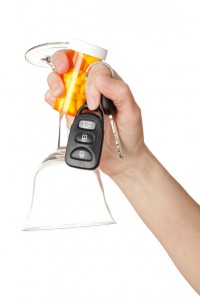
Alcohol and Other Drugs: It is all substance impaired driving
Those intent on abusing prescription medications can obtain them through a variety of methods, such as the black-market or “pill mill” doctor, or by going to a doctor and convincing that doctor that the need is genuine. People that abuse drugs will lie about their symptoms, and at times it is hard for a doctor to determine the truth. That may require physicians to start drug testing all of their patients. As Dr. DuPont noted, while such a step may offend some patients, it is an important process to ensure the medication is being prescribed for a legitimate purpose. These routine drug tests would also serve to inform doctors about other medications the patient is taking.
Pill mill doctors are doctors who are not operating ethically, and typically provide pain medication under the guise of treating the person. The pharmaceutical chain CVS attempted to shut down this type of doctor by examining its prescription data. After finding that a few doctors had written an unusually large number of prescriptions, CVS declared that these doctors would no longer have dispensing privileges. And what is “an unusually large number of prescriptions?” One doctor whose privileges were suspended had prescribed more than 44,000 doses of high-risk drugs, compared to other doctors in his region who had prescribed 662 doses.
Recommendations by Dr. DuPont
In wrapping up, Dr. DuPont has two key recommendations to reduce drug impaired driving:
- Regularly drug test everyone who is arrested and convicted for impaired driving, whether it is because of alcohol or other drugs, and
- Every state must pass a ‘per se” law to address those who drive with illegal drugs or with prescription medication without a prescription. It is a law with a zero tolerance for illegal drugs. As he noted, this is similar to the ‘per se’ laws already in effect for alcohol nationwide.
In my closing comments I note the importance of parents talking to their children about drugged driving. ONDCP has developed a very useful tool kit with the facts on the dangers of teen and young adult drugged driving, and activities for effective prevention, a link can be found below.
Related Links:
Websites:
- Centers for Disease Control & Prevention
- Institute for Behavior and Health Website
- National Institute on Drug Abuse
- Office of National Drug Control Policy – Drugged Driving
- Stop Drugged Driving Website
Research:
- 2007 National Roadside Survey of Alcohol and Drug Use by Drivers – NHTSA
- Drug Involvement of Fatally Injured Drivers – NHTSA Traffic Safety Facts – November, 2010
- Drugged Driving White Paper – IBH
- Drug Use and Fatal Motor Vehicle Crashes
Other:
- CVS Suspends Privileges of Doctors
- Traffic Safety Guy Blog – Drugged Driving: The Time Has Come for Action
Previous Episodes:
Video Clips:
03 – Gerald Waters: Making a Difference in New Zealand

October 12, 2013 | Posted in Global Road Safety, Podcast Episodes | By Traffic Safety Guy
Comments Off on 03 – Gerald Waters: Making a Difference in New Zealand
Podcast: Play in new window | Download
Subscribe: RSS
One Person Can Be a Beacon of Change

Gerald Waters (front, center) receiving the Barry Sweedler Award
Gerald Waters is one of New Zealand’s leading advocates on ways to effectively respond to alcohol and drug offenders. In 2010, his dear friend Katherine Kennedy was killed because of a drink driver. (“Drink Driving” is how New Zealand refers to impaired driving.) Gerald has committed himself to learning about, researching, and promoting evidence-based ways to end drink driving.
Hearing that the man who killed his friend had 17 prior drink driving convictions, and yet he was still drinking and driving, was “madness.” After this terrible tragedy, Gerald turned to understanding why this madness occurred. It was that journey that allowed him to develop his research and ultimately his message of change. Using his evidence-based research papers, and a drive for understanding, Gerald has brought together an impressive coalition of partners, and is changing how New Zealand responds to drink drivers. In this episode, Gerald discusses his journey and lets us hear about his perseverance and determination.

One Person Can Make a Difference
During our conversation, Gerald talks about building the coalition, and how he met individuals all across New Zealand who agreed with his research, and had previously felt that they were left in the dark, alone. With the power of his writing and the passion of his voice, Gerald let those individuals know that they were not alone and change is possible. He has become an inspiration of positive change. Because of Gerald’s activities, New Zealand has taken a fresh look at ending drink driving through the use of ignition interlock devices, DWI/Drug Courts, and more. Margaret Mead once said “Never doubt that a small group of thoughtful, committed citizens can change the world. Indeed, it is the only thing that ever has.” Change is happening in New Zealand, and it can happen where you live.
Wrapping up, the Traffic Safety Guy discusses making changes in our own lives. It shouldn’t take the loss of a family member or friend for us to care. All it takes is an understanding that individually we can make a difference. “Change” starts at home. It means talking the talk and walking the walk. As a positive role model for not drinking and driving, we can impact our family and friends and save lives. As a positive role model we can all be an inspiration and make a difference.
Related Links:
Gerald Water’s Websites:
A Partial List of Gerald Water’s Research:
- Submission to the Transport and Industrial Relations Select Committee
- The Case for Alcohol and Other Drug Treatment Courts in New Zealand
- Was This Preventable?
Global Road Safety:
Richard Roth’s Website:
02 – Vehicle Safety: Buying a Safer Car with Joseph Nolan, IIHS

October 3, 2013 | Posted in Car Safety, Podcast Episodes | By Traffic Safety Guy
Comments Off on 02 – Vehicle Safety: Buying a Safer Car with Joseph Nolan, IIHS
Podcast: Play in new window | Download
Subscribe: RSS
Joseph Nolan, Vice President for Vehicle Research at the Insurance Institute for Highway Safety (IIHS), speaks with me about what you can do to buy a safer car. While the IIHS is involved in a wide range of highway safety activities, one of their best known is their ratings developed from car crash testing. Five types of crashes are done by the IIHS, with each scored separately:
- Moderate overlap front
- Small overlap front (less of the car is impacted than in the moderate overlap)
- Side
- Roof strength, and
- Head restraints.
IIHS Safety Rating for Cars
Once a car is put through each crash test, it receives an overall rating: Poor, Marginal, Acceptable or Good. A vehicle that receives a “Good” rating in the moderate overlap front, side, roof strength, and head restraint tests is deemed a Top Safety Pick by the IIHS. If the car rates a “Good” in 4 out of 5 tests and “Acceptable” in the 5th, then it gets a Top Safety Pick + (Plus).

IIHS Vehicle Research Center
The IIHS started doing crash testing in the early 90s with one crash test, the moderate overlap front. At that time, many of the cars were rated either “Marginal” or “Poor.” Today, nearly all cars earn “Good” ratings in this crash test. As each new crash test has been added, car manufacturers have responded, designing safer cars in each attribute. Receiving the IIHS Top Safety Pick is now a valued recognition of the work done by car manufacturers and it is often included in their car advertising. To see the ratings of cars or trucks, go to www.IIHS.org. The Institute has a YouTube channel where you can watch many of the crashes. In the very near future, The Institute will also be examining and comparing a variety of the new crash avoidance technologies.
Safer Car App
Before my conversation with Mr. Nolan, I talk about the NHTSA 5-Star Safety Rating Program, which provides information about crash protection and rollover safety of new vehicles beyond what is required by Federal Law. One star is the lowest rating, with five stars being the highest. To find the ratings for your car, check out the website: SaferCar.gov. There, you can enter the make, model, and year and get a summary of how your car did in the safety tests.
NHTSA’s SaferCar App
Also, to help keep in touch with the various ratings done by NHTSA while out shopping for a new car, you can download the SaferCar app. It is available on iTunes, with an Android version currently in development. This app allows you to check out the various car ratings from your iPhone or iPad, see if there have been any recalls, or file a complaint. The app even provides help in installing a child safety seat.
Related Links:
Websites:
Phone App:
Other:
Video:
- 50th Anniversary of the IIHS – Crashing a 1959 Chevrolet Bel Air and a 2009 Chevrolet Malibu
01 – Impaired Driving: NTSB’s Plan to End It

September 28, 2013 | Posted in Impaired Driving, Podcast Episodes | By Traffic Safety Guy
Comments Off on 01 – Impaired Driving: NTSB’s Plan to End It
Podcast: Play in new window | Download
Subscribe: RSS
Impaired driving has been a part of our culture for over a century, with nearly 10,000 people now killed annually. Can we stop it, once and for all, so that no one else is killed by an impaired driver?
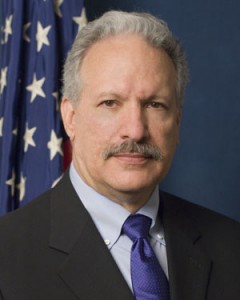
Dr. Mark Rosekind, NTSB Board Member
Dr. Mark Rosekind, NTSB (National Transportation Safety Board) Board Member, is a leading expert on the steps to take to end impaired driving. In this episode, Dr. Rosekind provides an overview of NTSB’s 19 research-based recommendations to achieve that goal. These recommendations cover a wide variety of perspectives—everything from stopping the social drinker from taking the risk of driving after drinking, to getting the repeat DWI (Driving While Impaired) offender to change his or her behavior. The recommendations also look at a number of actions and tools that can be used in this critical effort, such as ignition interlocks, DWI courts, and sobriety checkpoints. This conversation with Dr. Rosekind examines some of these topics in detail, including:
- What ignition interlocks are and the critical role they play
- The DADSS program (The car of the future?)
- Reducing the BAC (Blood Alcohol Concentration) from .08% to .05%, and
- DWI Courts for the repeat DWI offender
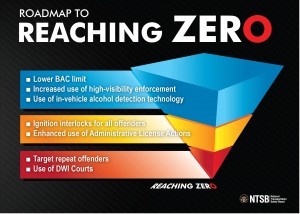
NTSB’s Pyramid to End Impaired Driving
Laying out the steps NTSB took to develop these recommendations, and detailing what several of them mean, Dr. Rosekind provides a comprehensive discussion on how we can end impaired driving. At the end of our conversation, Dr. Rosekind provides his suggestions on what we as individuals can do to make a difference and save lives.
Also during this episode, I talk about why we need a recommitment to stopping impaired driving, and an understanding what a .08% BAC means, referencing the B4U Drink Educator.
This podcast was also video-recorded. You can watch some of the clips from this conversation by going to the Videos page on this website.
Related Links:
Website:
Research:
Other:
Video Clips:
00 – Highway to Safety is About Hope

September 8, 2013 | Posted in Podcast Episodes | By Traffic Safety Guy
Comments Off on 00 – Highway to Safety is About Hope
Podcast: Play in new window | Download
Subscribe: RSS
Making my community a safer place to live is my (David Wallace) mission in life, and the career I chose certainly supports that resolve:
- A former assistant prosecuting attorney in Michigan for 16 years,
- A Traffic Safety Resource Prosecutor (TSRP)—someone who trains prosecutors and law enforcement about traffic safety issues, and,
- The Director of the National Center for DWI Courts—specialty courts for the repeat drunk driver.
All three positions allowed me to make a difference in my community and save lives, whether “my community” was local, state, national, or even global.
But there is more to do. So back in April I created the Traffic Safety Guy. As a traffic safety consultant, I educate, train, and support those who are working to make our roads safer for me, my family, my friends and anyone else that travels along our roads.
This podcast, Highway to Safety, is one more step in that effort. I believe that knowledge is power and if people know and understand what it takes to be safer on the road, that will help them take the next step. This podcast is about providing knowledge, raising awareness, and giving everyone the tools to be a safer driver.
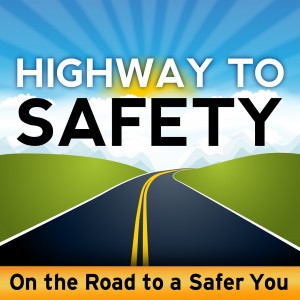
However, above all, this podcast is about Hope. I believe that in my lifetime we will achieve near-zero deaths on our nation’s roads. With a consistent message and continued effort, it will happen. And in highway safety, there is no other more fitting goal to than working towards zero deaths. This is not a pipe dream; we have come a long way—but more has to be done. Part of that includes you becoming involved, whether it is choosing a safer car when buying one, having a child safety seat properly installed, not drinking alcohol and then driving, or so many other “little” things that all add up to lives saved.
So I invite you to sit back and listen as I bring you conversations with policy makers, traffic safety professionals, and the people who make a difference every day of their lives. I offer you the opportunity to hear their stories of passion, and hope, that one day no one will die because of an impaired driver or someone that was texting on the phone while driving.
I invite you to join me on this journey, a journey to become a safer driver, and in the process, save lives.



